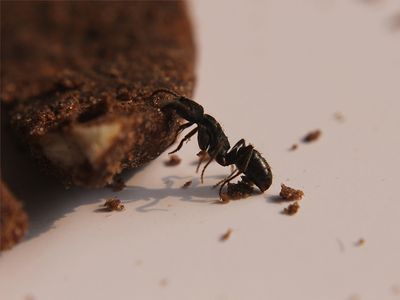What do deer ticks look like?
Deer ticks, or blacklegged ticks, begins as seed ticks. As seed ticks, they only have six legs. They grows another set when they become adults. When seed ticks first hatch, they are small enough to balance on the blunt tip of a pencil. At full size, deer ticks are about ⅛ of an inch in length. They have reddish-brown bodies and black legs. Males are entirely black. Females have a black oval of coloration toward the head and a reddish-brown coloration away from the head.

Why are they called deer ticks?
Blacklegged ticks commonly feed on white-tailed deer, and deer play a key role in spreading these ticks. But deer are far from the only animals these ticks will feed on. They're carried by everything from crawling mice to flying birds.
Are deer tick bites dangerous?
Deer ticks are potentially dangerous. While not every tick that feeds on you is infected with a pathogen, a tick that is infected poses a serious risk to your health. Here are only a few of the many diseases spread by blacklegged ticks.
Lyme Disease: Blacklegged ticks are a primary vector for this disease. Lyme can turn into a chronic disease and create lifelong health issues.
Babesiosis: This parasitic infection affects red blood cells and can lead to flu-like symptoms that present a serious health concern for certain individuals.
Powassan Virus: This rare but serious viral infection can cause encephalitis, which is a swelling of the brain.
There are other noteworthy diseases spread by ticks, such as Rocky Mountain spotted fever, Borrelia miyamotoi disease, ehrlichiosis, tularemia, and more. We recommend scanning resources on the CDC website to learn about them.
Are Lyme disease and other tick-borne diseases prevalent in the Tri-Cities of Virginia?
Yes. The climate and wooded areas in our region, along with the distribution of these diseases, make them a risk for residents in Richmond, Charlottesville, and Roanoke.
Where do ticks hide the most?
You'll most likely find these ticks hiding in humid vegetation on your property. They need moisture for survival, and they will climb vegetation and wait for an animal host to pass by. You'll also find them in dark, secluded locations where animals nest or sleep.
How do I protect my pets from ticks?
To protect your pets from deer ticks, we recommend using a vet-approved tick preventative. You should also groom your pets regularly, check for ticks after outdoor excursions, and keep your yard picked up and your lawn trimmed. We also suggest addressing rodent activity and discouraging wildlife that carry ticks from hanging around.
How do I get rid of deer ticks on my property?
For help eliminating and preventing deer ticks in your yard or elsewhere on your property, contact Evergreen Pest Solutions today! Our seasonal mosquito control service not only targets mosquitoes but it also exterminates deer ticks and fleas as well. From April through October, our team provides monthly treatments that ensure Virginia residents don’t have to worry about biting pests or the diseases they spread.
How can I prevent ticks?
Along with guarding your dog or cat, managing wildlife on your property, and signing up for seasonal protection, we recommend:
- Regularly mowing the lawn to keep grass short.
- Clear out dense vegetation and overgrowth.
- Haul away brush, leaf litter, and other debris.
- Keep shrubs and trees well-trimmed and away from walkways and play areas to minimize tick contact with people and pets.
- Do not position outdoor furniture, picnic tables, or swing sets under trees or near woody areas.








